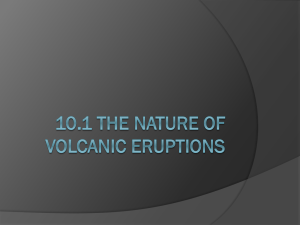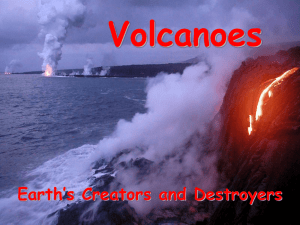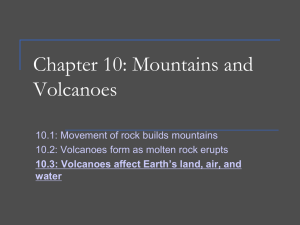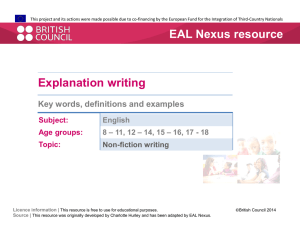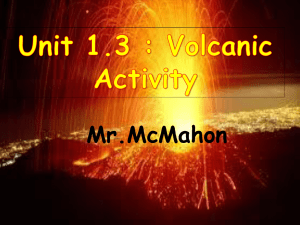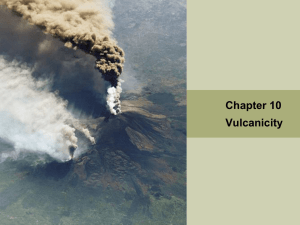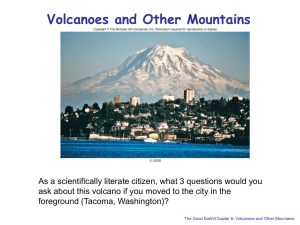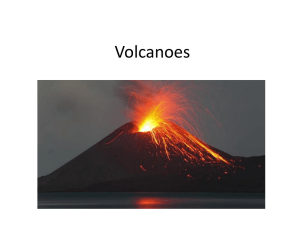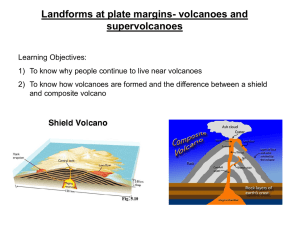Earthquakes and Volcanoes
advertisement
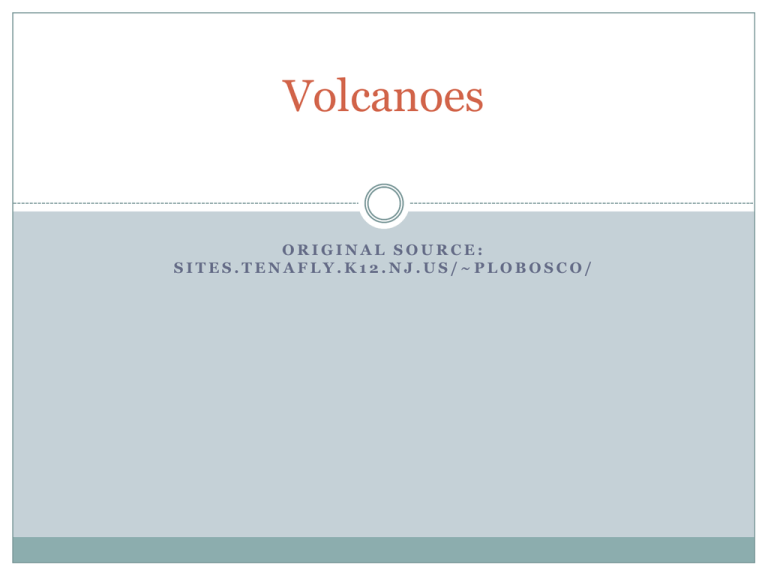
Volcanoes ORIGINAL SOURCE: SITES.TENAFLY.K12.NJ.US/~PLOBOSCO/ Volcanoes and Earth’s Moving Plates Objectives: To describe how volcanoes can affect people. To discuss the conditions that cause volcanoes. Identify the relationship between volcanoes and Earth’s moving plates. Volcanoes A volcano is an opening in the Earth that erupts gases, ash and lava. Kilauea is the world’s most active volcano. Lava When the magma reaches the surface, it is called lava. The place in the Earth’s surface through which magma and other materials reach the surface is called a volcano. In some places, lava can build up to form a cone-shaped mountain. The opening from which lava erupts is the vent. Volcanoes often have more than one vent. Formation of a Volcano The opening where lava flows out is a vent. The steep walled depression around the vent is a crater. Volcanoes Volcanoes can be both destructive and constructive forces. Destructive Effects of Eruptions Lava destroys everything in its path. Ash can cause lung damage. If ash and debris run down the side of the mountain, this is called a pyroclastic flow. Temperatures in this flow can be hot enough to ignite wood. Sulfurous gases can mix with water vapor and form acid rain that kills plants and animals. Constructive Effects of Eruptions The soil formed from volcanoes is very fertile and will eventually lead to abundant plant growth. The sulfur in volcanic vents along the ocean floor allow life to exist without sunlight Volcanoes recycle earth’s minerals Where do Volcanoes occur? Volcanoes form along divergent plate boundaries, convergent boundaries and hot spots. Divergent Plates Volcanoes often form where plates are moving apart, such as the Surtsey in Iceland. Iceland is located on the Mid Atlantic Ridge. Convergent Plate Boundaries Soufriere Hills On the Island of Monserrat is an example of a volcano that formed when one plate slide under another and melted. The magma was forced up and formed a volcano. Hot Spots Some volcanoes form over hot spots in the mantle. These are not on a plate boundary but in the center of a plate. The Hawaiian Islands formed over a hot spot in the Pacific Plate. Types of Volcanoes Objectives: To discuss how explosiveness of a volcano is related to the silica and water content. To discuss the three types of volcanoes. Magma Deep within the Earth, under tremendous pressure and at great temperatures, rock exists as a hot liquid called magma. This molten rock is found in pockets called magma chambers. What Controls Eruptions? Eruptions are controlled by 1) the amount of trapped gas and the water vapor 2) how much silica is present in the magma Trapped Gas As magma reaches the surface, it is under less pressure. Gas can escape. Gas escapes easily during quiet eruptions. If gas build up to high pressure this will cause an explosive eruption. Amount of Water Vapor The magma at some convergent boundaries contains a lot of water vapor. This is because oceanic plate material and some of its water slide under other plate material at some convergent plate boundaries. The trapped water vapor in the magma can cause explosive eruptions. Viscosity of Magma Magma is divided into two major types: silica rich and silica poor The greater the silica content, the more viscous or thick the magma. Basaltic Magma Magma that is low in silica is called basaltic magma. It is fluid and produces quiet flows such as those at Kiluea. Basaltic lava flows under water produce pillow lava formations. Basaltic Lava Pahoehoe (p-hoi-hoi) forms a smooth, billowy, ropelike surface. Aa, flows at a lower temperature, is stiff and slow moving. https://encryptedtbn1.gstatic.com/images?q=tbn:ANd9GcQxYSoNsSaKu47pJNuJkI E49xVUxFS-fXrKwh50nQnXPV0OrUB7 https://encryptedtbn1.gstatic.com/images?q=tbn:ANd9GcT8SfzZoqkv0Yu2Dsyr2xQyB3iTaE0S53LoDL1wYIH1vlB C2hmySQ Gaseous Lava When lava that contains large amounts of gases, such as steam and carbon dioxide, hardens it forms rocks with many holes in them, due to the gas bubbles. Pumice and scoria are igneous rocks formed from this type of lava. https://encrypted-tbn2.gstatic.com/images?q=tbn:ANd9GcSlJYtYiNswbpjWkiOrzUzpySSw-UEbaw4L9RyuDZeFbCokLFXEA 3 Types of Volcanoes Different types of volcanic eruptions form different types of volcanoes. Cinder cones Shield volcanoes Composite volcanoes Cinder Cones They are steep sided cones of basaltic fragments and are smaller and simpler than composite volcanoes. Streaming gases carry liquid lava blobs into the atmosphere that fall back to earth around a single vent to form the cone. The volcano forms when ash, cinders pile up around the vent to form a circular or oval cone. Most common kind of volcano http://www.k12.hi.us/~kapunaha/student_projects/volc_blowout/cinder_cone_volcano.htm https://encryptedtbn3.gstatic.com/images?q=tbn:ANd9GcSeCsTPToq3GDWqNxDijDfx1gIDwDm1RpArCYsmE17 MskSPmCezfw Tephra Explosive eruptions throw lava and rock high into the air. Bits of rock or solidified lava dropped from the air are called tephra. The smallest particles are called volcanic dust. (less than 0.25 mm) Volcanic Ash ( 0.25 -5mm) falls to the Earth and forms small rocks. Cinder (5mm-a few cm) Volcanic bombs (a few cm to several meters) are molten and harden as they travel through the air. Paricutin Volcano in Mexico http://4.bp.blogspot.com/-x6k8MObhuIg/T0vDJmMSxI/AAAAAAAAGv8/myMqukEGkwk/s1600/paricutin.jpg Shield Volcanoes Volcanoes composed of quiet flows are called shield volcanoes. Because it is runny, the lava flows over a large area. After several eruptions, a dome-shaped mountain is formed such as Mauna Loa (4km over sea level) in the Hawaiian Islands. Mauna Loa, Hawaii – Earth’s Largest Volcano http://hvo.wr.usgs.gov/maunaloa/4303062_M.jpg http://hvo.wr.usgs.gov/maunaloa/ Flood Basalts Basaltic lava can also flow onto Earth’s surface through large cracks called fissures. This type of eruption forms flood basalts Columbia Plateau was formed as the lava spread out over the ground. Composite Volcanoes (Stratovolcano) Most deadly Volcanoes built up of alternating layers of rock particles and lava are called composite volcanoes. During the formation of a composite volcano, a violent eruption first occurs, hurling volcanic bombs, cinder and ash out of the vent. Then a quiet eruption, produces lava flow that covers the rock particles. Lower slope is gentle, but they rise steeply toward the summit Composite Volcano (Stratovolcano) Mount Vesuvius (near Naples, Italy) http://www.history.com/topics/pompeii/videos Mount St Helens http://dsc.discovery.com/tvshows/discoverypresents/videos/understandingvolcanoes-mt-saint-helens.htm Krakatau One of the most violent eruptions in recent times occurred on an island in the Sunda Straits neat Indonesia in 1883. 36,000 people were killed. The island fell into the magma chamber. http://www.history.com/s hows/how-the-earth-wasmade/videos/the-krakatoavolcano#the-krakatoavolcano Igneous Rock Features Objectives To describe intrusive rock features. To explain how a volcanic neck and a caldera form. Predicting Volcanoes There are four indicators of volcanic activity: Rising magma (increase in electric current) Seismic activity (tremors) Ground deformation Changes in gases (carbon dioxide and sulfur dioxide) Instruments used to Detect Volcanic Activity Tiltmeters are sensors that use laser beams to help create map of the physical changes in the earth’s surface that rising magma causes. Scientists also measure the levels of gases escaping, such as carbon dioxide and sulfur dioxide. Gravimeters measure the electrical currents given off by magma. An increase indicates a rise in the level of magma The most recent development uses satellites to detect heat from the gases released by volcanoes. The satellite Landsat uses infrared sensors. Limits of Seismography in Detecting Volcanic Activity Seismographs cannot determine magma height, depth or how fast the magma is rising. Crater There is often a funnel-shaped pit or depression at the top of a volcanic cone. This pit is called a crater. If the crater becomes very large as a result of the collapse of its walls, it is called a caldera. A caldera may also form when the top of a volcano explodes or collapses. Volcanic Crater Intrusive Igneous Rock Features Most magma never reaches the surface. Much of it hardens in the earth. Sometimes the hardened magma becomes exposed at the surface. These rock bodies are called intrusive igneous rock features. Examples are batholiths, sill, dikes and volcanic necks. Batholiths The largest intrusive igneous rock bodies are called batholiths. They form when magma bodies that are being forced upward cool and solidify before reaching the surface. Yosemite National Park The granite domes of Yosemite National Park are exposed batholiths. Sills and Dikes Magma sometimes squeezes into cracks below the surface. Magma that cuts across rock layers and hardens is called a dike. Magma that is forced into a crack parallel to the rock layers and hardens is a sill. Volcanic Neck When a volcano stops erupting, magma will harden inside the vent. Erosion wears away the outside of the volcano and the solid igneous rock in the vent remains. Ship Rock in New Mexico was formed this way. Calderas Sometimes after an eruption, the top of a volcano can collapse. This produces a large depression called a caldera. Crater Lake in Oregon is a caldera that filled with water and is now a lake. Volcanic Activity Volcanoes are rather unpredictable. Some erupt regularly, others have not erupted in modern history. Scientists classify them as active, dormant or extinct. Active Volcanoes An active volcano is one that erupts whether continually or periodically such as Mount Katmai in Alaska and Mount St. Helens in the Cascade Range. Dormant Volcano A volcano that has been known to erupt within modern times but is now inactive is classified as a dormant volcano. Mount Rainier in Washington state is an example of a dormant volcano in the United States. Scientists can be wrong. Mount St. Helens was considered to be dormant but erupted after long periods of inactivity. Extinct Volcano A volcano not known to have erupted within modern history is classified as an extinct volcano. They have been worn away almost to the level of their magma chamber. Volcano and Earthquake Zones Most major earthquakes and volcanic eruptions occur in three zones of the world. Scientists believe that there is a great deal of movement and activity in the Earth’s crust in these three zones. Ring of Fire One major earthquake and volcano zone extends nearly all the way around the edge of the Pacific Ocean. This zone goes through New Zealand, the Philippines, Japan, Alaska and along the western coasts of North and South America. The San Andreas fault is part of this zone. Ring of Fire Mediterranean Zone A second Major earthquake and volcano zone is located near the Mediterranean Zone and extends across Asia into India. Many countries in the zone, including Italy, Greece and Turkey, have violent earthquakes. Many volcanic eruptions also occur in this zone. Mid-Atlantic Ridge Zone The third major earthquake and volcano zone extends through Iceland and to the middle of the Atlantic Ocean. Under the ocean, there is a long range of volcanic mountains called the Mid-Atlantic Ocean Range. Scientists believe that the volcano and earthquake activity are due to the formation of new parts of the Earth’s crust along the ridge. The volcanic island of Iceland is part of this zone. Earthquake Belts .

